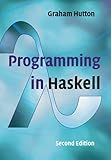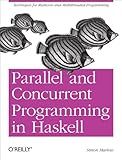Best Haskell Programming Books to Buy in December 2025

Learn You a Haskell for Great Good!: A Beginner's Guide
- QUALITY ASSURANCE: EACH BOOK IS GENTLY USED, ENSURING GOOD CONDITION.
- AFFORDABLE PRICES: SAVE MONEY WHILE ENJOYING GREAT READS.
- ECO-FRIENDLY CHOICE: SUPPORT RECYCLING BY BUYING USED BOOKS.



Programming in Haskell



Effective Haskell: Solving Real-World Problems with Strongly Typed Functional Programming



Learn Physics with Functional Programming: A Hands-on Guide to Exploring Physics with Haskell



Real World Haskell
- AFFORDABLE PRICE FOR QUALITY READING MATERIALS
- ENVIRONMENTALLY FRIENDLY CHOICE FOR BOOK LOVERS
- GREAT VARIETY OF TITLES TO DISCOVER AND ENJOY



Get Programming with Haskell



Learn Haskell by Example (Bookcamp)



Parallel and Concurrent Programming in Haskell: Techniques for Multicore and Multithreaded Programming



Haskell in Depth



Thinking Functionally with Haskell


In Haskell, you can enforce run-time conditions on data by using various techniques. Here are a few commonly used approaches:
- Using Guards: You can define a function with guards to enforce certain conditions at run-time. Guards allow you to specify different expressions to evaluate based on certain conditions. For example: calculate :: Int -> String calculate x | x > 0 = "Positive number" | x < 0 = "Negative number" | otherwise = "Zero" In this example, the calculate function uses guards to check the value of x and return an appropriate string based on the condition.
- Using Pattern Matching: Haskell's pattern matching allows you to match specific patterns and perform different actions. By defining different patterns for different conditions, you can enforce run-time constraints. For example: calculate :: Int -> String calculate x = case x of n | n > 0 -> "Positive number" n | n < 0 -> "Negative number" _ -> "Zero" Here, the calculate function uses pattern matching to check the value of x and return the corresponding string.
- Using Custom Data Types: Another approach is to create custom data types with strict constraints. By defining your own types and constructors, you can enforce run-time conditions on the data they represent. For instance: data PositiveNumber = Positive Int createPositive :: Int -> Maybe PositiveNumber createPositive x | x > 0 = Just (Positive x) | otherwise = Nothing In this example, the PositiveNumber data type ensures that it can only represent positive integers. The createPositive function uses a Maybe type to indicate success or failure in creating a PositiveNumber.
These are just a few techniques for enforcing run-time conditions on data in Haskell. You can choose the approach that best fits your requirements and design your functions accordingly.
What is the impact of enforcing run-time conditions on overall program reliability in Haskell?
Enforcing run-time conditions in Haskell can have a positive impact on overall program reliability. Haskell is a statically-typed functional programming language, which means that it performs rigorous type-checking at compile-time, which reduces the probability of common runtime errors such as type mismatch or null pointer exceptions.
By enforcing run-time conditions, such as pre and post-conditions, assertions, or error handling, Haskell programs can detect and handle unexpected inputs or invalid states, leading to improved reliability. These conditions allow programmers to specify expectations about the code's behavior, and if any violation occurs during runtime, appropriate actions can be taken, like raising an error, logging a message, or providing fallback mechanisms.
In addition, enforcing run-time conditions can lead to improved fault tolerance and resilience. By implementing mechanisms like exception handling, Haskell programs can gracefully recover from unexpected errors or exceptional conditions and continue execution without crashing or corrupting the program state.
Moreover, enforcing run-time conditions can also enhance code maintainability and readability. By explicitly defining expectations about the program execution and handling possible failures, it becomes easier for developers to understand the code, reason about its behavior, and make modifications without introducing errors.
However, it is worth noting that enforcing excessive or unnecessary run-time conditions may introduce overhead in terms of performance or code complexity. Therefore, it is essential to strike a balance and focus on enforcing conditions that mitigate critical failure scenarios while keeping the codebase manageable and efficient.
What is the impact of enforcing run-time conditions on code modularity in Haskell?
Enforcing run-time conditions on code in Haskell can have both positive and negative impacts on code modularity.
- Positive Impact: Increased modularity: Enforcing run-time conditions can lead to more modular code by allowing the separation of concerns in programs. Conditions can be checked at runtime to ensure correct input values and handle exceptions appropriately. This promotes better encapsulation and separation of responsibilities, making the code more modular. Improved code reusability: By enforcing run-time conditions, code becomes more robust and can be reused across different modules and projects. Modular code with well-defined run-time conditions can be easily integrated into other applications, enhancing code reusability.
- Negative Impact: Reduced scalability: In complex systems, enforcing run-time conditions can sometimes affect scalability negatively. Runtime checks can introduce overhead, slowing down the program execution. As the codebase grows and more run-time conditions are enforced, the scalability of the system might be impacted. Potential reduction in performance: Runtime checks and conditions can add computational costs and affect the performance of the code. In performance-critical applications, enforcing extensive run-time conditions might lead to decreased performance.
Overall, while enforcing run-time conditions in Haskell promotes code modularity and reusability, it is essential to strike a balance and consider the potential impact on scalability and performance, especially in performance-critical systems.
How to validate data inputs at run-time in Haskell?
In Haskell, you can validate data inputs at run-time using various techniques. Here are a few approaches you can consider:
- Using the Maybe type: You can define a function that checks the validity of the input and returns a Maybe type. If the input is valid, it returns Just the validated data, otherwise, it returns Nothing. Here's an example:
validateInput :: String -> Maybe Int validateInput input = case reads input of [(num, "")] -> Just num _ -> Nothing
In the above example, the function reads converts the input String into a list of pairs. The first element of each pair is the parsed value, and the second element is the remaining String after parsing. The pattern match (num, "") checks if there is a single number parsed without any remaining input, indicating a valid input.
- Using error handling: You can use the error function to throw an exception if the input is invalid. Here's an example:
validateInput :: String -> Int validateInput input = case reads input of [(num, "")] -> num _ -> error "Invalid input"
In this case, if the input is valid, the function returns the parsed value, otherwise, it throws an error message.
- Using data types: If you have complex input validation requirements, you can define a custom data type and use smart constructors to ensure only valid data can be created. Here's an example:
data ValidatedInput = ValidInput Int
createInput :: Int -> Maybe ValidatedInput createInput num | num > 0 = Just (ValidInput num) | otherwise = Nothing
In this example, the createInput function acts as a smart constructor that checks whether the input is valid or not. If it's valid, it returns a Just value containing the validated input, otherwise, it returns Nothing.
These are just a few examples of how you can validate data inputs at run-time in Haskell. The approach you choose depends on the complexity of the validation logic and the desired behavior for invalid inputs.
What is the difference between static type checking and run-time condition enforcement in Haskell?
Static type checking and run-time condition enforcement are two different approaches to ensuring program correctness in Haskell.
Static type checking is performed at compile-time and is designed to catch type errors before the program is executed. Haskell has a powerful type system that uses type inference to deduce the types of expressions and functions. The type system ensures that operations are applied to the correct types, and it enforces type safety by preventing incompatible types from being combined. Static type checking helps identify potential errors early in the development process, reducing the likelihood of runtime errors and improving program reliability.
Run-time condition enforcement, on the other hand, is done during program execution. Haskell provides a mechanism called "pattern matching" that allows programmers to define functions based on the shape of data structures. When pattern matching is used, the Haskell runtime system checks whether the given value matches any of the defined patterns. If the value does not match any pattern, a run-time error occurs. This mechanism ensures that the program handles all possible cases explicitly and prevents unexpected values from causing undefined behavior or crashes.
In summary, static type checking in Haskell prevents type errors at compile-time, while run-time condition enforcement ensures that all cases are explicitly handled during program execution. Both mechanisms contribute to the overall correctness and robustness of Haskell programs.
